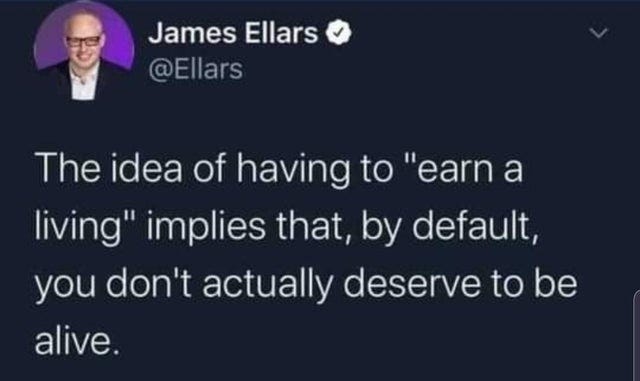⚙️✨The Nexialist #0040
Lollygag | A Measure of Sacrifice | Solarpunk and the End of Capitalism | Dark Solarpunk | Antiwork
Welcome to another week of brain-sparking links:
I just got back from a beautiful family trip and found some time to share some links with that post-vacation vibe (even though I’m still on vacation for a few days.) Again, I will keep it short and I hope this sparks some nexus in your brain.
🍭Lollygag
I love those “word of the day” series and Lollygag immediately sparked something in my brain. It reminded me of the Italian expression Dolce far niente, or sweet idleness.
Lollygag: spend time aimlessly; idle; to fool around and waste time;
Examples of lollygag in a Sentence:
-He was kicked off the team for lollygagging during practice.
-Stop lollygagging around and get to work!
⌛️A Measure of Sacrifice
Walking around with my parents, they noticed how many churches/clock towers there are in Amsterdam. I immediately remembered this text:
Clock time is a fungible measure of sacrifice. Of all measurement instruments, the clock is the most valuable because so many of the things we sacrifice to create are not fungible. The massive clock towers of Europe, with their enormous loud and resonant bells, broadcasting time fairly across the town and even the countryside, rather than the last relics of the medieval, were the first building block of the wealthy modern world. The Europeans evolved their institutions and deployed two very different but complementary timekeeping devices, the sandglass and the mechanical clock, to partition the day into frequently rung and equal hours. Europe progressed in a virtuous circle where bells and clocks improved the productivity of relationships; the resulting wealthy institutions in turn funded more advances in timekeeping.
The rise of the cities and the merchant revolution was given a temporary setback by the Black Plague, the very century that the clock was introduced, but thereafter economic growth renewed with unprecedented vigor. The massive change on the farm, the dominant form of industry, in the 14th and successive centuries from serfdom and slavery to markets and wage labor, was caused not only by the temporary labor shortages of the Black Plague, but more fundamentally and permanently by the time-rate contract and the new ability to accurately and fairly verify its crucial measurement of sacrifice, time. Time rates also became the most common relationship for the mines, mills, factories, and other industries that rapidly grew after the advent of the clock.
Read: A Measure of Sacrifice, by Nick Szabo (From David Perell’s Friday Finds)
🌞Solarpunk and the End of Capitalism
“Solarpunk took inspiration from the Cyberpunk and Steampunk aesthetics that came before it—take the lush paradises of Studio Ghibli films with just a few more solar panels. Cyberpunk uses science fiction to explore our anxieties in the rapidly developing technical age, while Steampunk is nostalgic for the aesthetics of the industrial revolution. But unlike these dystopian and mechanical universes, Solarpunk is a more optimistic, regenerative vision of the future.
It imagines a world where energy, usually from the sun or wind, can be used without harming our environment. Where green roofs and windmills allow humans to live in harmony with nature. On the surface it might seem like a rosy, perhaps even naive perspective for our moment, when climate change-fueled disasters are in the news every other day. But imagining Solarpunk purely as a pleasant aesthetic undermines its inherently radical implications. At its core, and despite its appropriation, Solarpunk imagines an end to the global capitalist system that has resulted in the environmental destruction seen today.”
Read: Solarpunk Is Not About Pretty Aesthetics. It's About the End of Capitalism - VICE - By Hannah Steinkopf-Frank
🌝Dark Solarpunk
Despite the fact that the genre is still being developed, Solarpunk has a lot to resources to take inspiration from, being cli-fis (climate fictions) or in the way that writers such as Ursula K. Le Guin, Octavia Butler and Samuel Delany addressed aliens and the metamorphosis between humans and nature to discuss themes such as gender, race and politics. Solarpunk could be a genre that is attractive even to the most pessimistic and grim fans of cyberpunk, because it doesn’t need to tell only naive stories of a post-apocalyptic optimism that aims to heal our current anxiety. In fact, solarpunk can also recover other tropes that address the transformation of humanity and its displacement from the center of everything to actually become part of the whole. So this is me venting to myself and to other authors who wish to approach this more “gothic” side of solarpunk — because nature could be as frightening as in the movies by Lars Von Trier.
Read: Beyond the green smart cities, solarpunk can also be dark | by Lidia Zuin | Medium
💪🏼r/antiwork
Recently this trending subreddit got my eyes.
❤️If anything made your brain tingle, click like and don't hesitate to share it with the world. It helps The Nexialist to reach more curious minds. See you next week!🦦
🫀If you enjoyed this newsletter, please share it with your friends. If someone amazing sent it to you, tell them you love them, and you can subscribe at thenexialist.substack.com. If you want to know what a Nexialist is, click here.
🤙Call me…
If you like what you see here and your project, brand or business needs some ideas or inspiration from outside your bubble, maybe you need a Nexialist to help you out 🙋🏻♂️ I can participate in brainstorms and workshops, guide inspiration sessions, or provide you with creative research. You can always send me an e-mail to figure something out together.








